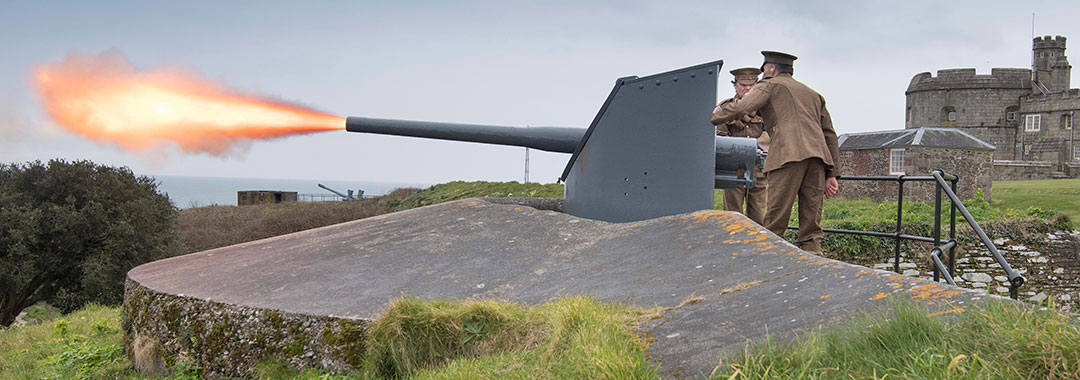
Newly conserved Edwardian 12-Pounder quick-firing gun being fired at Pendennis Castle in Falmouth, Cornwall.
English Heritage has launched an appeal to save some of the nation’s historic cannons. The call comes as the charity reveal a newly conserved Edwardian gun as part of a new project at Pendennis Castle.
SWINDON, UK, 2018-Apr-03 — /Travel PR News/ — England’s historic cannons at coastal locations around the country are at risk of damage from sea spray and salty air.
English Heritage has today launched a campaign to tackle urgent repairs to four historic guns. These guns — one each at Pendennis Castle and Dover Castle and two at Etal Castle — have been identified as those most in need of care.
Conservation work is already underway at Pendennis Castle where, as part of a £1 million project, some of the guns in the collection have been conserved and redisplayed. A highlight is the chance to see and hear a rare 12-pounder quick-firing gun in action with a crew in uniform of the Edwardian period. Now English Heritage needs your help to continue this work.
Senior Collections Conservator Bethan Stanley says the care of the cannons is a complex process.
‘Our cannons are precious objects, vital alongside our castles and fortifications in telling the story of England as an island nation. To many, they are an integral part of the landscape, but unless we act now, they could ultimately be lost to the elements.
‘Coastal guns are regularly battered by strong winds blowing corrosive moisture and salt spray over them which means that, untreated, they can corrode 20 times faster than those just a mile or so inland.’
English Heritage has completed intensive conservation to the cannons and carriages on the Garrison Walls at St Mary’s on the Isles of Scilly. Work is also scheduled for the 16th-century cannon at Pevensey Castle in Sussex.
With the public’s support, English Heritage conservators will be able to carry out more of this much needed conservation, starting with those cannons in urgent need of attention.
Support our cannons and make a donation.
HOW YOUR DONATIONS WILL HELP
Your support will benefit four cannons which the charity’s experts have identified as being in urgent need of care.
Two identical 18th-century cannons at Etal Castle, Northumberland
- These cannons are cast iron 9-pounder cannons and are said to have been salvaged from the HMS Royal George, an English ship that sank in 1782.
- The cannons have flaking paint and small areas of corrosion which, if left untreated, can thin the metal and weaken the structure. To save them, conservators need to remove them from their carriages, remove old paint and corrosion and repaint the metal with protective paint. They also need replacement carriages.
A Second World War anti-aircraft gun at Pendennis Castle, Falmouth
- This quick firing 3.7-inch anti-aircraft gun was designed in the 1930s and by 1941 it was Britain’s primary anti-aircraft gun, firing 10 to 20 shells per minute and reaching a distance of up to 30,000 ft. The guns were sent down to Falmouth to cover the build-up of troops and supplies embarking for the D-Day landings.
- Suffering from extensive damage, conservators will need to deconstruct the gun to remove paint and corrosion using air abrasion cleaning. They will also need to repaint the surface, wax internal areas and re-install it on a new platform.
A Second World War anti-aircraft gun at Dover Castle, Kent
- By April 1940 there were 12 of these mobile anti-aircraft guns in the Dover defences. Like Falmouth, defences at Dover were increased during the build-up to D-Day. Between June and August 1944, 28 of these cannons were deployed to the town.
- Like the cannon at Pendennis Castle, this quick firing 3.7-inch anti-aircraft gun has been damaged by the sea air. It’s also been subject to the corrosive power of pollution from the busy port it overlooks. It’s suffering from extensive deterioration, with flaking paint and a thinning of the metal . It requires a deconstruction, new paintwork and trailers.
Find out more about saving England’s cannons and make a donation.
See the newly conserved quick-firing gun in action at Pendennis Castle.
For more from English Heritage, follow us on Facebook, Twitter and Instagram.
SOURCE: English Heritage
Please call or email if you have any media enquiries.
020 7973 3390
